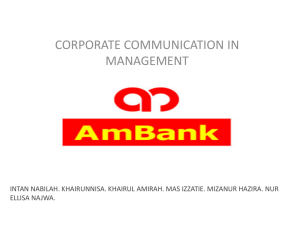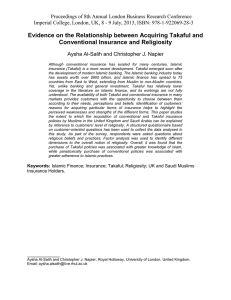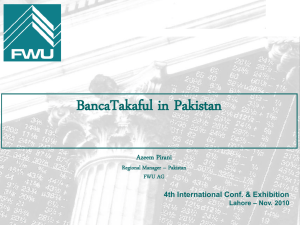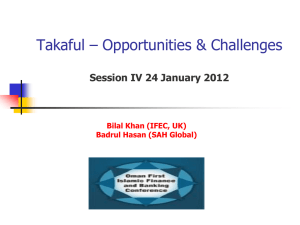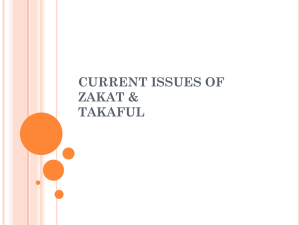– An Overview Takaful Funds By Professor Dr Mohd Ma’sum Billah Introduction
advertisement
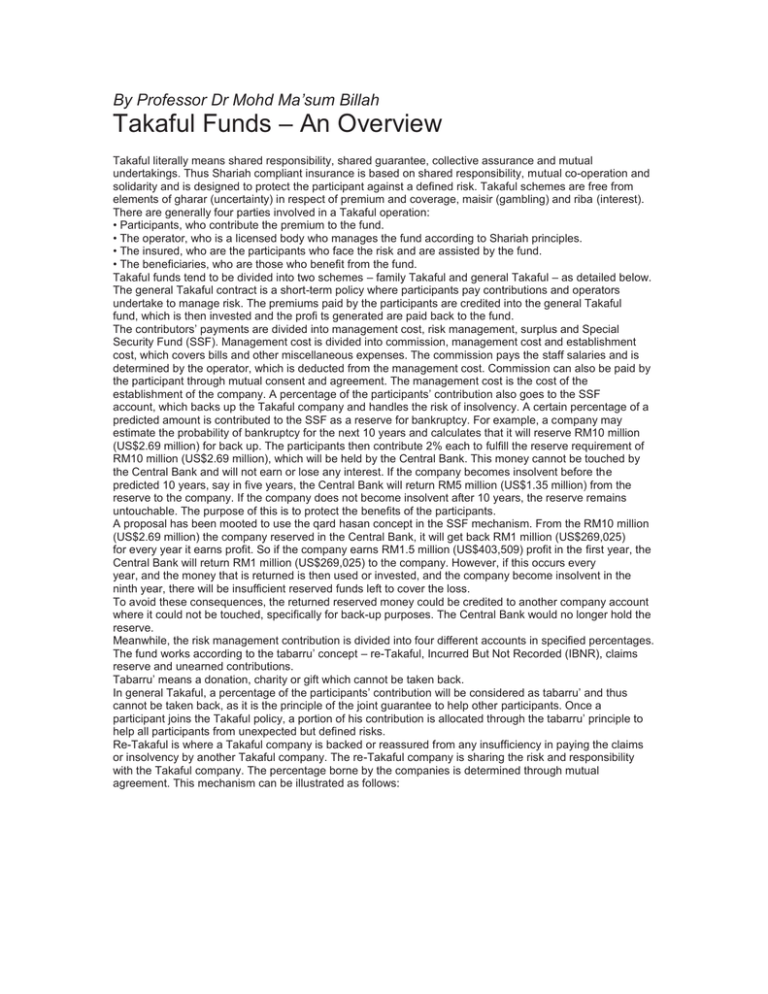
By Professor Dr Mohd Ma’sum Billah Takaful Funds – An Overview Introduction Takaful literally means shared responsibility, shared guarantee, collective assurance and mutual undertakings. Thus Shariah compliant insurance is based on shared responsibility, mutual co-operation and solidarity and is designed to protect the participant against a defined risk. Takaful schemes are free from elements of gharar (uncertainty) in respect of premium and coverage, maisir (gambling) and riba (interest). There are generally four parties involved in a Takaful operation: • Participants, who contribute the premium to the fund. • The operator, who is a licensed body who manages the fund according to Shariah principles. • The insured, who are the participants who face the risk and are assisted by the fund. • The beneficiaries, who are those who benefit from the fund. Takaful funds tend to be divided into two schemes – family Takaful and general Takaful – as detailed below. The general Takaful contract is a short-term policy where participants pay contributions and operators undertake to manage risk. The premiums paid by the participants are credited into the general Takaful fund, which is then invested and the profi ts generated are paid back to the fund. The contributors’ payments are divided into management cost, risk management, surplus and Special Security Fund (SSF). Management cost is divided into commission, management cost and establishment cost, which covers bills and other miscellaneous expenses. The commission pays the staff salaries and is determined by the operator, which is deducted from the management cost. Commission can also be paid by the participant through mutual consent and agreement. The management cost is the cost of the establishment of the company. A percentage of the participants’ contribution also goes to the SSF account, which backs up the Takaful company and handles the risk of insolvency. A certain percentage of a predicted amount is contributed to the SSF as a reserve for bankruptcy. For example, a company may estimate the probability of bankruptcy for the next 10 years and calculates that it will reserve RM10 million (US$2.69 million) for back up. The participants then contribute 2% each to fulfill the reserve requirement of RM10 million (US$2.69 million), which will be held by the Central Bank. This money cannot be touched by the Central Bank and will not earn or lose any interest. If the company becomes insolvent before the predicted 10 years, say in five years, the Central Bank will return RM5 million (US$1.35 million) from the reserve to the company. If the company does not become insolvent after 10 years, the reserve remains untouchable. The purpose of this is to protect the benefits of the participants. A proposal has been mooted to use the qard hasan concept in the SSF mechanism. From the RM10 million (US$2.69 million) the company reserved in the Central Bank, it will get back RM1 million (US$269,025) for every year it earns profit. So if the company earns RM1.5 million (US$403,509) profit in the first year, the Central Bank will return RM1 million (US$269,025) to the company. However, if this occurs every year, and the money that is returned is then used or invested, and the company become insolvent in the ninth year, there will be insufficient reserved funds left to cover the loss. To avoid these consequences, the returned reserved money could be credited to another company account where it could not be touched, specifically for back-up purposes. The Central Bank would no longer hold the reserve. Meanwhile, the risk management contribution is divided into four different accounts in specified percentages. The fund works according to the tabarru’ concept – re-Takaful, Incurred But Not Recorded (IBNR), claims reserve and unearned contributions. Tabarru’ means a donation, charity or gift which cannot be taken back. In general Takaful, a percentage of the participants’ contribution will be considered as tabarru’ and thus cannot be taken back, as it is the principle of the joint guarantee to help other participants. Once a participant joins the Takaful policy, a portion of his contribution is allocated through the tabarru’ principle to help all participants from unexpected but defined risks. Re-Takaful is where a Takaful company is backed or reassured from any insufficiency in paying the claims or insolvency by another Takaful company. The re-Takaful company is sharing the risk and responsibility with the Takaful company. The percentage borne by the companies is determined through mutual agreement. This mechanism can be illustrated as follows: When there is any claim from the participants that the Takaful company cannot meet, the re-Takaful company will cover, for example, 30%, and the Takaful company will provide the remaining 70%. In reTakaful there are two coverage systems available: the facultative and the treaty systems. Facultative is a product-by-product coverage, meaning that it only covers a particular specified policy, such as fi re. The treaty system, however, covers the whole range of claims and is divided into two conditions, compulsory or optional. The treaty system is compulsory when the government requires the Takaful company to reassure its policies in a specified percentage. It would be optional whether to have a re-Takaful company or not. Incurred But Not Recorded IBNR is when a participant makes his claim after the policy period, although he suffered his accident during the policy period. This situation is regarded as IBNR and the payment of the claim should be made from the claim reserve account. Claims reserve The payment of all claims made within the policy period is made out of the claim reserve account. Unearned contributions Unearned contribution is an account to back up any accrued accounts. For example, if there is an accrual in the claim reserves account, the unearned contribution account will cover the accrued amount. After the claim has been paid and costs deducted, any surplus will be put in the surplus account. There are three differing opinions regarding whether surplus should be returned to the risk management fund; returned to the participants in the surplus account according to their contributions; or shared between the operator and the participants. Types of general Takaful schemes General Takaful is comprised of five main classes – fi re Takaful, miscellaneous and accident Takaful, marine Takaful, engineering Takaful and motor Takaful – with various divisions within these classes. (See diagram below). Family Takaful, or life insurance, does not mean insuring one’s life, but is a financial protection for the heirs or beneficiaries of the deceased (or insured) against future unexpected fi nancial risk. Family Takaful is based on the principle of Mudarabah, which relies on the principles of mutual cooperation. Life Takaful consists of two types of accounts: Participant’s Account (PA) and Participant’s Special Account (PSA). The PA is treated in line with the principle of Mudarabah, while the PSA is treated on the basis of tabarru’ or donation. If the risk occurs, beneficiaries have the right to claim policy value from the PSA, as well as the accumulated amount from the PA. Profit is distributed to participants according to their contribution or investment in the family Takaful fund, based on the terms and conditions applied by the company. The contribution paid by the participants in family Takaful is divided into four parts. A certain percentage of the premium paid is allocated for management costs, which comprises commission, management costs and the SSF account. The majority of the contribution paid for family Takaful is invested in PA and PSA. The contribution received from the participant is credited to the PA and PSA in a defined percentage split, as illustrated by the diagram below. If a participant makes a claim within the policy period, the beneficiaries are entitled to benefits from the PSA fund, as its purpose is to provide financial security for the participants. However, if there is no claim made during the policy period, the participant can claim from the PA fund only. The reason for this is that the participant is a donor to the tabarru’ fund, which cannot be taken back. The tabarru’ rate as determined by actuaries is affected by: the expected claim rate; the incidence of claim; the basic cover; the reserving basis; the profit-sharing expectation between the operator and participant; and any expenses or commission loading. If the participant’s PSA fund has a large surplus, the operator can donate some of this to charity or use it to develop the social infrastructure. Additional benefits of Family Takaful If a participant who paid his premiums for 25 years met with an accident and died, or was permanently paralyzed, within his policy period, his beneficiaries could claim all of the benefits from both the PA and PSA accounts. If an accident befell a participant during the policy period which did not lead to any serious harm or death, compensation would be awarded according to his condition. A participant who made no claims during the policy period can only claim from the PA. Family benefits – if a participant paid life Takaful premiums for a 10-year policy period and died within the policy period, the benefits would be distributed among his beneficiaries. Other benefits include those relating to permanent disabilities and hospital benefits. Advantages of Family Takaful Some of the advantages of holding a Family Takaful policy are that: the participants can select the maturity date; profit sharing is according to the agreed ratio; the policy can be terminated at any time; withdrawal can be effected in the following ways: • if less than two years, the participant will be charged RM30 (US$8.20); • if more than two years, 50% of the PA can be withdrawn without charge; • if more than five years, 70% of the PA can be withdrawn without charge. There also exists some flexibility to change the premium paid, the period and the number of installments in one year, and there is additionally exemption from income tax. Conclusion Takaful is primarily based on co-operation and helping others against a defined risk. A Takaful policy is meant to protect the participants financially, via the premium paid by them and through the policies provided, based on the Islamic principles of Mudarabah and tabarru’. The development of Takaful as an alternative to conventional insurance should be upheld in order to avoid the forbidden elements of maisir, gharar and gambling. Takaful Funds – An Overview (continued...) The author is Islamic corporate advisor on Shariah compliance of banking, fi nance, investment, Takaful, reTakaful, business, wealth, asset and property management, capital market, bond (Sukuk) market, money market and e-commerce. He is a Professor of Islamic fi nance at the Faculty of Islamic Finance, University of Camden, USA (Malaysian Center). He can be contacted by email on: masum2001@ yahoo.com; website: http//.www.applied-islamicfi nance.com.
